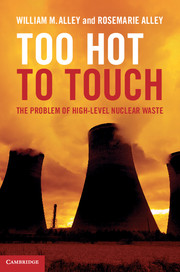Book contents
- Frontmatter
- Contents
- Acknowledgments
- List of units
- List of abbreviations
- Introduction
- Part I The problem
- Part II The mountain
- 12 The search for a geologic repository
- 13 Nevada wins the lottery
- 14 The Nevada Test Site
- 15 Yucca Mountain
- 16 How long is long?
- 17 Leaving almost no stone unturned
- 18 Surprise
- 19 Shake & bake
- 20 The project gets into hot water
- Part III No solution in sight
- Appendix Discussion questions
- References
- Index
15 - Yucca Mountain
from Part II - The mountain
Published online by Cambridge University Press: 05 February 2013
- Frontmatter
- Contents
- Acknowledgments
- List of units
- List of abbreviations
- Introduction
- Part I The problem
- Part II The mountain
- 12 The search for a geologic repository
- 13 Nevada wins the lottery
- 14 The Nevada Test Site
- 15 Yucca Mountain
- 16 How long is long?
- 17 Leaving almost no stone unturned
- 18 Surprise
- 19 Shake & bake
- 20 The project gets into hot water
- Part III No solution in sight
- Appendix Discussion questions
- References
- Index
Summary
And it is not our part here to take thought only for a season, or for a few lives of Men, or for a passing age of the world. We should seek a final end of this menace.
Gandalf in The Lord of the RingsThe year was 1972. The proposed salt repository at Lyons, Kansas was in its death throes. Environmentalists were demanding a solution to the waste problem or shutting down the entire nuclear industry. Caught off guard, the AEC contracted with the US Geological Survey to study other geologic media, look further afield, think outside the salt-box. Dr. Isaac “Ike” Winograd, a research scientist for the USGS, had been doing just that. At the annual meeting of the Geological Society of America, Ike proposed using the thick unsaturated zone somewhere in the American Southwest for long-term storage of solidified high-level waste. In the world of high-level radioactive waste, this was quite the revolutionary idea.
For over a decade, burial in salt had been essentially the only game in town. The USGS had a long-standing concern with this medium – salt can behave in a highly unpredictable manner in the presence of the extremely high heat generated by high-level waste. The other option being considered for geologic disposal was to bury the waste below the water table, deep in the saturated zone. Burying the waste in water would protect the canisters from oxidation. Uranium in the spent fuel is also more stable in the absence of oxygen. Yet, even then, eventually the canisters would be breached and radionuclides released. A major challenge with a saturated-zone repository was how to build a solid, secure repository surrounded by all that water, and then seal it back up.
- Type
- Chapter
- Information
- Too Hot to TouchThe Problem of High-Level Nuclear Waste, pp. 217 - 232Publisher: Cambridge University PressPrint publication year: 2012



